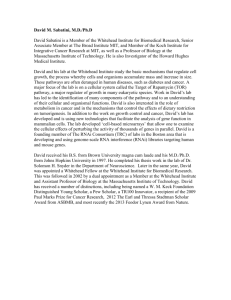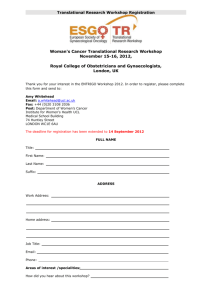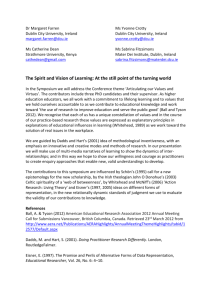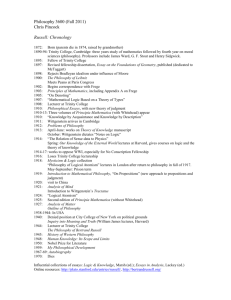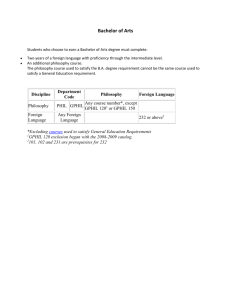Itow shigeyuki Paper
advertisement
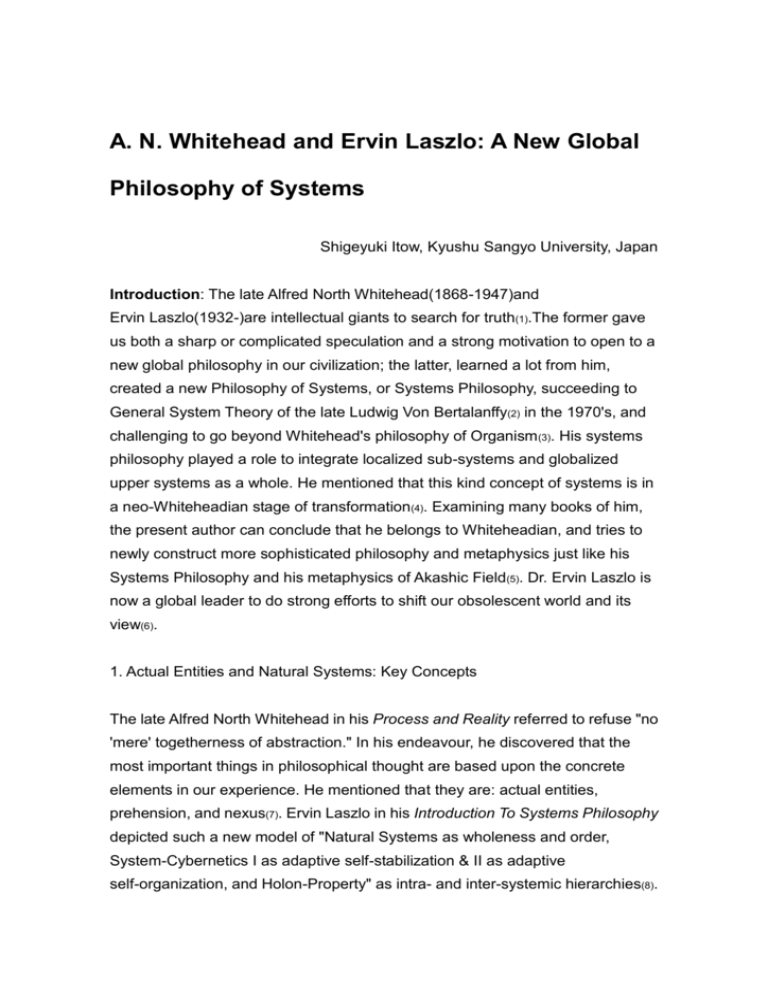
A. N. Whitehead and Ervin Laszlo: A New Global Philosophy of Systems Shigeyuki Itow, Kyushu Sangyo University, Japan Introduction: The late Alfred North Whitehead(1868-1947)and Ervin Laszlo(1932-)are intellectual giants to search for truth(1).The former gave us both a sharp or complicated speculation and a strong motivation to open to a new global philosophy in our civilization; the latter, learned a lot from him, created a new Philosophy of Systems, or Systems Philosophy, succeeding to General System Theory of the late Ludwig Von Bertalanffy(2) in the 1970's, and challenging to go beyond Whitehead's philosophy of Organism (3). His systems philosophy played a role to integrate localized sub-systems and globalized upper systems as a whole. He mentioned that this kind concept of systems is in a neo-Whiteheadian stage of transformation(4). Examining many books of him, the present author can conclude that he belongs to Whiteheadian, and tries to newly construct more sophisticated philosophy and metaphysics just like his Systems Philosophy and his metaphysics of Akashic Field(5). Dr. Ervin Laszlo is now a global leader to do strong efforts to shift our obsolescent world and its view(6). 1. Actual Entities and Natural Systems: Key Concepts The late Alfred North Whitehead in his Process and Reality referred to refuse "no 'mere' togetherness of abstraction." In his endeavour, he discovered that the most important things in philosophical thought are based upon the concrete elements in our experience. He mentioned that they are: actual entities, prehension, and nexus(7). Ervin Laszlo in his Introduction To Systems Philosophy depicted such a new model of "Natural Systems as wholeness and order, System-Cybernetics I as adaptive self-stabilization & II as adaptive self-organization, and Holon-Property" as intra- and inter-systemic hierarchies(8). (1)ACTUAL ENTITIES(Whitehead)/NATURAL SYSTEMS(Laszlo) ACTUAL ENTITIES: According to Whitehead, the final real things of which the world is ontologically made up are: actual entities. They are real things and differ among themselves, and such actual entities are God, he mentioned. Also he referred that the final facts are, all alike, actual entities; and these actual entities are drops of experience, complex, and interdependence(9).Whitehead's terms of actual entities or actual occasions are a organism that grows, matures, and perishes(10). NATURAL SYSTEMS: Whitehead's actual entities can be permissible to transform into more scientific and philosophical term of today: systems. Laszlo tries to replace his actual entities of organism into the new term of systems. His transformation of systems goes more precisely into "natural systems" as systemic state property of wholeness and order(11). The latter is an assemblage or combination of real things, parts, or correlated elements forming a complex and integrated whole in the changing process of natural systems. Systems are always plural and make a network of systems, not one single system that can not be survive in a real world. It can not alive as isolated with no energy and no information. A system is alive with another system in energy and information exchange process; therefore, such a system as open one interdepends another system, which in turn interdepends or (re)produces other systems. Thus Laszlo says that the real things are systems in the world. Such systems differ among themselves, and different systems produce different systems just like many things in experience, diversity, complexity, and integrated whole (12). In my understanding of them except systematic system, any systems are complementary, not dichotomized in spirit and matter like dualism. (2)PREHENSION(Whitehead)/SYSTEM-CYBERNETICS I & II(Laszlo) PREHENSION: Whitehead argued that, with the purpose of obtaining a one-substance cosmology, 'prehensions' are a generalization from Descartes' mental 'cogitation,' and from Locke's 'ideas,' to express the most concrete mode of analysis applicable to every grade of individual actuality. He also explained that a prehension reproduces in itself the general characteristics of an actual entity: it is referent to an external world, and in this sense will be said to have a 'vector character;' it involves emotion and purpose, and valuation, and causation. In fact, any characteristic of an actual entity is reproduced in a prehension. It might have been a complete actuality; but, by reason of a certain incomplete partiality, a prehension is only a subordinate element in an actual entity. A reference to the complete actuality is required to give the reason why such a prehension is what it is in respect to its subjective form. This subjective form is determined by the subjective aim at further integration, so as to obtain the 'satisfaction' of the completed subject. In other words, final causation and atom are interconnected philosophical principles(13). Prehension has two aspects: negative and positive. The former consists of "exclusion from contribution to the concrescence; "the later consists of "feelings." The feelings contributed to the concrescence consist of three phases: conformal, conceptual, and comparative. The last one is divided into simple and complex comparative feelings. SYSTEM-CYBERNETICS I & II: Whitehead's prehension shown as the sensational feeling interdependence between the subject- object relation can more scientifically be translated into Laszlo's System-Cybernetics I as adaptive self-stabilization & II as adaptive self-organization in Cybernetics. Every system is always composed of smaller or larger, or internal or external systems in different levels of new integrating processes. In this sense, systems have always interfaces with inner or outer world, or subject systems and objective systems, as Whitehead's prehension is referent to the external world. Any systems, internal or external are prehended in a manner of input-output relation with feedback loops in Cybernetics. That which systems are in input-output relation with them means that any systems input and output a kind of energy or information with feedback loops. This is a characteristic of open systems, not closed or isolated. Thus open systems can be defined as real systems embedded in a feedback process inputting and outputting any free energy and information. This kind of systems is called "living." Therefore, any living systems are open. If any physical, biological, and social systems in our world are open, then we can define that they are "living systems." In general, physical systems process a larger volume of energy and a smaller one of information; biological systems process a full of energy and information more than physical ones; and social systems process a relatively smaller energy and a relatively larger information in due ones, and process much larger volume of information than physical and biological ones(14). Next, let us consider that any living systems as open ones input and output a kind of energy and information. That one system inputs energy and information outputting the other system, inputting another outputted energy and information shows systems relatedness in a real world. Such systems relatedness can be described as input-output relation and also connected with feedback loops in each different level of systems. By new changing or changed relations, any systems make different systems like physical, biological, and social ones; changes of relationship make diversity of systems. Such changes are concerned with systems subjectivity which can analyze into functions of perceiving, monitoring, choosing, feeling, loving, memorizing, evaluating, judging, learning, creating, imaging, mapping, projecting, and so on. Systems objectivity emerges from new results of such functions. Systems subjectivity and objectivity create a new world of environment containing a lot of data each system inputs and outputs. All these kinds of systems are a self-pattern of "living" in input-output relation. Such systems as adaptive self-stabilization and adaptive self-organization are living and open in that they consist of body (processing energy) and mind(processing information). These sorts of living and open systems evolved a complex and diversified society(15). (3)NEXUS(Whitehead)/INTRA- AND INTER-SYSTEMIC HIERARCHIES(Laszlo) NEXUS(NEXUS): Whitehead argued as follows: actual entities involve each other by reason of their prehensions of each other. There are thus real individual facts of the togetherness of actual entities, which are real, individual, and particular, in the same sense in which actual entities and the prehensions are real, individual, and particular. Any such particular fact of togetherness among actual entities is called a'nexus'(plural form is written 'nexus')(16). The ultimate facts of immediate actual experience are actual entities, prehensions, and nexus. Whereas subjective forms are private matters of fact, nexus is public matters of fact calling society or societies. Society and societies enjoy social order. They change from subject to object, and from object to superject in a dynamic process. Such dynamic process, putting into Laszlo's intra- and inter- systemic hierarchies, can emerge a new nexus in the different levels. INTRA- AND INTER-SYSTEMIC HIERARCHIES: Such hierarchies are shown as Arthur Koestler's Holon Property(17). What Holon is interests to us for understanding what whole or part is mathematically or philosophically. Laszlo argued that, given systems which constitute ordered wholes, adaptively stabilizing themselves in their environment around existing steady-states as well as evolving themselves to more adapted, and normally more negentropic(or informed) states, development will be in the direction of increasing hierarchical structuration(18). As to Koestler's holon property, Laszlo translated itself into intraand inter-systemic hierarchies, constructed and emerged as a result of "self-stabilizing and self-organizing ordered wholes in common environments.(19)" The idea of intra- and inter-systemic hierarchies are may derive from Chinese one in history(20). The paper craft in China exhibits a structure of Chinese boxes. The craft is composed of many boxes, small or large, and of large boxes inside a lot of small boxes. So it is defined that Chinese boxes structure within boxes within boxes within boxes, which you can see as their application in computer operation when you do click. Any such structures of Chinese boxes can be shown as systems structures that are full of systems within systems within systems just like Chinese boxes in the paper craft in China. In this form, systems such as living as subject throughout processes of energy and information prehend or interdepend smaller living systems prehended, and smaller living systems as object act against a new prehension of larger and more stable order of living systems. If the new prehension can achieve by matching, then new order of living systems emerge there as superject. The superject never can reduce to the former object or subject because it could shape up a new wholeness in a new dimension. In this way, any living systems change, evolve, reform, and create a world of living systems(21). In this respect, the late Erich Jantsch mentioned that "evolution creates wholeness which interacts autonomously with other wholeness.(22) " As a result, such living systems make the world in time-space more diversified, more differentiated, more integrated, more complicated, and more opened in self-stabilizing and self-organizing processes just like our sola system in cosmos. (4)WHAT ERVIN LASZLO LEARNS FROM A. N. WHITEHEAD As a Hungarian-born and international famed pianist, Ervin Laszlo started his life from New York city. While he performed as his pianist all over the world, he was interested in learning from a synthetic philosophy of A. N. Whitehead. He said, "eventually I came across Whitehead. In his 'philosophy of organism' I believed I had found an answer meriting sustained consideration.(23)" He also mentioned that "Whitehead was illuminating, but not the final answer.(24)" He then completed notes which took on the character of a Whiteheadian process philosophy and centered on man and society, but founded on the natural scientific world picture. The notes finally published as Essential Society: An Ontological Reconstruction(25). This book showed as going beyond Whitehead's Philosophy of Organism and as being already in a neo-Whiteheadian stage of transformation(26). On this connection, Thimothy E. Eastman, however,commented misleadingly(27). As his first systems philosopher, Ervin Laszlo learned from the first Whitehead and the second Ludwig von Bertalanffy. He replaced Whitehead’s notion of "organism" and its Platonic correlates with the concept of a dynamic, self-sustaining "system" discriminated against the background of a changing natural environment(28). By this replacement it means that he updated to more scientific synthesis of systems than complicated idea of organism led to a kind of vitalism. As his cybernetics master, Ervin Laszlo learned from the first Whitehead referring to a kind of concrescence process of "many into one" and the second Norbert Wiener's cybernetics model of "input-output and feedback relation". He applied Whitehead's concrescence process and Wiener's cybernetics model into "musical activity" among the composer, the performer, and the listner(29). Norbert Wiener studied abroad to University of Cambridge in the 1910's under A. N. Whitehead and B. Russell who friendly co-worked for completing a new formal logic of Principia Mathematica. After going back to the U.S., he created a new discipline of Cybernetics focusing mainly on information and communication systems(30). As his global leader, Ervin Laszlo learned an adventure of ideas from Whitehead. His leadership covered professors' position at many universities in the world, and directors at the Club of Rome and the Club of Budapest, and in the research projects of the United Nations where Whitehead saw "no hope for the future of civilization apart from world unity based on sympathetic compromise within a framework of morality.(31)" Now he has propelled the WoldShift project(32) all over the world changing a path of unsustainability, conflict, and disharmony to a path toward sustainability, well-being, and harmony among people and between people and nature. Concluding Remarks: we understand that both Whitehead and Laszlo are intellectual giants, who has encouraged us to understand truth, goodness, beauty and peace. Now we have recognized that Laszlo's systems philosophy could cover a new development of systems ideas, following Whitehead's philosophy of organism plus Wiener's Cybernetics. His standpoint of "everything is living and connected" will be accepted by Asian people, and will be effective to solve the present global problems: human crisis, water and air pollution, over-load against environment, and so on(33). In particular the present author can evaluate that Laszlo as European re-interpreted Asian cultures, or "Thinking Globally Acting Locally or Thinking Locally Acting Globally" time of "everything is living and connected" to construct a new global civilization. He has also contributed to teach us a new world perspective, a synthetic worldview, a constructive way of science and philosophy, and a way of goodness from himself. His systems ideas are now crystallizing a new philosophy of systemism which will go beyond individualism and collectivism in the past(34). REFERENCES (1) Alfred North Whitehead was Mathematician, Scientist, and Philosopher. His life was noted in his “Autobiographical Notes,” in Essays in Science and Philosophy, New York: Greenwood Press, 1968, pp. 3-14; Ervin Laszlo has been pianist, philosopher, and global leader. His life is noted in his “An Autobiographical Retrospective,” in Science and the Akashic Field, Rochester, Vermont: Inner Traditions, 2004, pp. 168-186. (2)See: Paul A. LaViolette(ed.), A Systems View of Man: Ludwig von Bertalanffy, Boulder, Colorado: Westview Press, 1981. (3)See: Ervin Laszlo, Beyond Scepticism and Realism: A Constructive Exploration of Husserinan and Whiteheadian Methods of Inquiry, The Hague: Martinus Nijoff, 1966; Ervin Laszlo, La Metaphisique De Whitehead, The hague: Martinus Nijhoff, 1970. (4)Ervin Laszlo, Introduction To Systems Philosophy, New York: Gordon and Breach, 1972, viii. (5)Ervin Laszlo adopted that the concept of Akasha(Akashic, adj)is a Sanskrit word meaning “ether” to understand cosmos.In my understanding it, I will choose an integrated pattern of energy and information only, not Akasha in cosmos. Cf.: Shigeyuki Itow, “The Possible Future of Asia-Pacific Order,” Business Review, Fukuoka, Japan: Kyushu Sangyo University, Vol. 20, No. 1, 2009, pp. 53-54; and cf., Shigeyuki Itow, A New Wave of Civilization from Japan, Tokyo: Keiso shobo, pp. 146- 158(in Japanese). (6) Ervin Laszlo, Macroshift, San Francisco, CA: Berrett- Koehler Publising, 2001; Ervin Laszlo, San Diego, CA: Waterside Productions, 2002. Dr. Seisaku Yamamoto appealed for a new historical view after mastering Whitehead’s philosophy: A Spiral view of History. See: Haruo Murata(ed.), Whitehead and Ethics in the Contemporary World: For Sustainability and Common Good, Kyoto: Shourai Sha, 2010. (7)A. N. Whitehead, Process and Reality, New York: Free Press, 1978, pp.18-36. (8)Ervin Laszlo, Introduction To Systems Philosophy, New York: Gordon & Breach, 1972, pp. 35-53. (9)Ervin Laszlo, Introduction To Systems Philosophy, New York: Gordon & Breach, 1972, p. 18. (10)Donard W. Sherburne(ed.), A Key To Whitehead’s Process and Reality, New York: Macmillan, 1966, p. 6. (11)P. B. Checkland, “Book Reviews(Systemic, Not Systematic): General System Theory, London: Penguin Books, 1973 By Ludwig von Bertalanffy,”Journal of Systems Engineering, Vol. 3, No. 2, 1972, pp. 149-150. In this paper, Checkland clearly distinguishes the two concepts of systemic and systematic. He also mentions that systemic is not classical physics or thermodynamics but systematic is so. See also(27)in this footnote. (12) Ervin Laszlo, Introduction To Systems Philosophy, New York: Gordon & Breach, 1972, pp. 36-38. (13) A. N. Whitehead, Process and Reality, New York: Free Press, 1978, p. 19. (14) Ervin Laszlo, Introduction To Systems Philosophy, New York: Gordon & Breach, 1972, pp. 38-47. (15) Shigeyuki Itow, Systems Politics, Tokyo: Keiso Shobo, 1987, pp. 25-38(in Japanese). (16) A. N. Whitehead, Process and Reality, New York: Free Press, 1978, pp. 20-22. (17) Arthur Koestler, The Ghost in the Machine, London: Hutchinson 1967 Ch. 3. (18) Ervin Laszlo, Introduction To Systems Philosophy, New York: Gordon & Breach, 1972, pp. 48-49. (19) Ervin Laszlo, Introduction To Systems Philosophy, New York: Gordon & Breach, 1972, pp. 48-49. (20) Ervin Laszlo, Introduction To Systems Philosophy, New York: Gordon & Breach, 1972, pp. 51-52. (21) Shigeyuki Itow, A. N. Whitehead’s Theory of Politics, Tokyo: Gakubun Sha, 2008, pp. 104-118(in Japanese). (22)Erich Jantsch, The Self-Organizing Universe: Scientific and Human Implications of the Emerging Paradigm of Evolution, Oxford: Pergamon Press, 1980, p. 261. (23) Ervin Laszlo, Introduction To Systems Philosophy, New York: Gordon & Breach, 1972, vii. (24) Ervin Laszlo, Introduction To Systems Philosophy, New York: Gordon & Breach, 1972, vii. (25)Ervin Laszlo, Essential Society: An Ontological Reconstruction, the Hague: Martinus Nijhoff, 1963; Ervin Laszlo, Individualism, Collectivism,and political Power, the Hague: Martinus Nijhoff, 1963. See: “In the 1960s, what meaning I found half-buried in particular fields I jotted down, and attempted to bring it into relation with what I found in other fields. I just wanted to understand what the world and life-my life,and life in general-are all about. I made copious notes, but never expected that they would get into print. How they did so is one of the curious episodes of my life,” in “An Autobiographical Retrospective” of his book: Science and the Akashic Field, Rochester, Vermont: Inner Traditions, 2004, pp. 169-170. (26) Ervin Laszlo, Introduction To Systems Philosophy, New York: Gordon & Breach, 1972, viii. (27)Timothy E. Eastman’s comment is as followed: The famous general systems theory of Ervin Laszlo was inspired by Whitehead’s philosophy. “I found...that the organic synthesis of Whitehead can be updated by the synthesis of a general systems theory, replacing the notion of ‘organism’ and its Platonic correlates with the concept of a dynamic, self-sustaining ‘system’ discriminated against the background of a changing natural environment”[Ervin Laszlo, Introduction to Systems Philosophy: Toward a New Paradigm of Contemporary Thought(New York: Gordon and Breach, 1972),viii]. However, his systems theory is classical whereas Whitehead’s philosophy of organism has clear quamtum aspects[private communication, David Finkelstein, March, 2002], Timothy E. Eastman and Hank Keeton(eds.), ”Duality Without Dualism,” Physics and Whitehead: Quantum, Process, and Experience, Albany, NY: State University of New York Press, p. 26. I[Itow] do not agree to Timothy E. Eastman’s comment of “classical.” His definition of classical is unclear in his paper of “Duality Without Dualism.”As one of systemists, I classfy two: one is systematic systems; the other systemic ones. The former is that “one and one is two” system is quite classical; but the latter is that it is neither“one and one is two” system(mechanical system), nor ”more than one and one is two” one(vitalistic system). This kind of system is systemic and holon property after quantum. In my definition, Ervin Laszlo’s standpoint is after quamtum. David Finkelstein may misunderstand two kind of systems: “systematic” and “systemic” systems. (28)Ervin Laszlo, Introduction To Systems Philosophy, New York: Gordon & Breach, 1972, viii. (29) Ervin Laszlo, “Cybernetics and Musical Activity,” Systems Science and World Order, Oxford: Pergamon Press, 1983, pp. 122-138. (30) Norbert Wiener, Cybernetics: or Control and communication in the Animal and the Machine, Mass.: MIT Press, 1948. (31) A. N. Whitehead, “An Appeal to Sanity,” Essays in Science and Philosophy, New York: Greenwood Press, 1968, p. 53. (32)Ervin Laszlo, WorldShift2012, Tokyo: Bio-Magazine, 2010. (33)Archie J. Bahm, “Asian Philosophies,” The Philosoper’s World Model, Westport, Connecticut: Greenwood press, 1979, pp. 82-84. (34) See: Shigeyuki Itow, A New Wave of Civilization from Japan, Tokyo: Keiso Shobo, 1995(6th Reprint, 2006), pp. 32-50 (in Japanese). (itow2011329)
